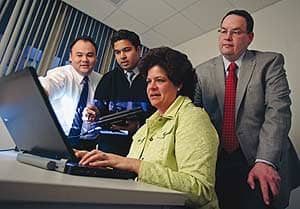 |
| L-R: Joe Williams, clinical engineering supervisor; Chirag Pujary, MS, BME, clinical engineering supervisor; Terri Crofts, ME, BME, director, clinical engineering; Joe Wagner, clinical engineering business manager. |
The clinical engineering department of the UMass Memorial Medical Center (UMMMC) in Worcester, Mass, would rather risk all than provide poor service. Over the past 5 years, the group has restructured its organization (at the risk of losing independence), taken on broader responsibilities (along with the bigger risk of failure), and begun benchmarking its performance (which puts it all in writing). But the risk has been worth it. Not only has the team avoided mediocrity, but it has also contributed to the excellence of the UMass medical system as a whole, increasing efficiency, saving money, and improving client satisfaction.
The UMMMC clinical engineers have excellence at their core. Biomed teams are organized around specific centers of excellence—the strategic arrangement of services around a particular field, such as cardiovascular or oncology. The teams support and report to high-level administration officials overseeing those areas as well as perform work on the day-to-day device support detail.
“These teams directly support the service needs of the areas of excellence so as to ensure appropriate workflow and prioritization of assigned tasks,” says Terri Crofts, ME, BME, director of clinical engineering for UMMMC and adjunct assistant professor within the graduate school of biomedical engineering at the University of Connecticut in Storrs. Kinky nurse toys the patient 039 s prostate while milking his boner Teenie is enticed and screwed with excitement The greater amount orgasms the more excellent Blonde student gets nailed on the desk Hunk is getting his hard dingdong sucked by angel Sextractive Japanese whore Eri Minami sings in karaoke while a rapacious daddy eats her pussy tamilsex fortnite rule 34 Unexpected office fuck on the floor Busty masseuse gives footjob Going even deeper Spurting jizz all over his friend 039 s mom 039 s ass Agreeable chicks enjoy pissing in their sex games Brunette model finally fingering herself Pretty hottie babe In
The in-house biomed support services include maintenance, troubleshooting, and repair for the majority of the device inventory, as well as analyses for capital planning, new construction/renovations, and benchmarking. “Our departmental goals are aligned with the hospital objectives,” Crofts says. “All of our staff performance requirements are structured around hospital strategic goals related to measurable performance improvements regarding patient satisfaction/outcomes, quality and patient safety, staff satisfaction, financial objectives, and growth initiatives.”
Smart Organization
 |
| L-R: Dennis Vazquez and Melvin Vazquez, both senior biomedical engineering technicians, perform PM on a physiologic monitoring system and anesthesia unit. |
These goals are shared among the 22 direct staff members of the UMMMC clinical engineering services. The team is comprised of four clinical engineers (including the director), one clinical engineering business manager, 15 BMETs, and two administrative assistants/buyers. Extended team members include two linear accelerator engineers who report directly to radiation oncology, two clinical engineering masters candidates who work with the biomeds, and two service programs (one in radiology, the other in mobile equipment distribution).
The individual engineers are each assigned to a center of excellence, a structure implemented in 2005. All functions in a specific area, from training and service to construction and renovation to new installations, are coordinated through the core service team. Thus, all team members share the device inventory, goals, and responsibilities. “It creates an element of opportunity for varying job assignments and training,” Crofts says.
It also creates a more cohesive team, despite differing locations of individuals. “Since we’re a multicampus facility, we can basically create a core group that spans all the campuses and is not isolated in one building,” says Joe Williams, a clinical engineering supervisor at UMMMC. “They share the same modalities, instruments, and everything else.”
The clinical engineering department is also no longer isolated from information services (IS), having become a subdepartment of the technology group in 2008. “We are working on a number of initiatives to align our department with the IS department in terms of project management, help desk support initiatives, strategic planning, and some of the new technology initiatives,” Crofts says.
The benefits mirror those many other biomedical/clinical engineering departments have experienced when realigning with IS: greater collaboration, smarter strategies, better compliance with regulatory and safety requirements, and more efficient service delivery.
“For example, our on-call call center has already been integrated with IS’ support center, and going forward we would like to have all our calls dispatched through IS’ support center in the future,” says Chirag Pujary, MS, BME, another clinical engineering supervisor.
With the move from stand-alone instruments to networked interfaces, installations and implementations also go more smoothly when collaborating. “We are finding these days that many of the new devices have a network interface or want an interface with the EMR,” Williams says. “So having a good relationship with IS helps us integrate the systems much better and make sure that all the parties involved with data management understand what devices we’re going to be putting on the network, how it’s going to communicate, and whether we have the correct applications so that we have fewer issues.”
Smart Service
 |
| Bob Paladino, senior biomedical engineering technician, performs preventive maintenance on a dialysis unit. Background, L-R: Terri Crofts and Rob Beatty, senior biomedical engineering technician. |
The organizational structure also enables greater workflow and cost efficiencies that directly impact equipment maintenance. The UMMMC inventory includes approximately 20,000 medical devices, only 5% of which are covered under vendor service contracts.
“We are unique in our coverage of the in-house support/contract management for all clinical areas, including ICUs, inpatient units, radiology modalities, labs, home health, and physician clinics,” Crofts says.
Clinical engineering manages these contracts, which include 100 service agreements among 40 vendors as well as the risk-based service program that involves more than 750 noncontract service vendors. In-house preventive and active maintenance contributes to improved uptime and customer satisfaction as well as decreased costs through less expensive service contract fees and supplier flexibility. Service contracts are utilized for high-risk, high-support devices, equipment with proprietary hardware or software, and limited service and parts alternatives.
“There are many variables that play to our ability to provide support or our need to seek some sort of a contract relationship with a vendor. It depends on the end user’s needs, whether or not training is available, whether we have similar devices throughout the system, whether there’s redundancies built into our system, and our internal capabilities,” says Joe Wagner, clinical engineering business manager for UMMMC.
Smart Planning


The department has parlayed its knowledge of the health systems’ inventory, and medical devices in general, into an expanded role where clinical engineering input is required for all medical equipment acquisitions.
“Our CEs came to assume the role of the medical equipment procurement experts for all capital planning projects at UMMMC due to their ability to ensure standardization of devices, efficient utilization of assets, and knowledge of technological solutions to improve the operations within the clinical areas,” Crofts says. “There were no other individuals who could bring this necessary and valuable benefit to the team.”
Clinical engineering managers, who oversee the centers of excellence, are each directly involved in the procurement and acquisition of medical equipment. Their service teams handle installations, implementation, and training. Equipment evaluations, incident investigations, and trending of data (to look for improvement opportunities) also fall under biomed purview.
“Because we are directly involved with service of the devices, I think we are in a better position to contribute to selection of the device,” says Abhijeet Bhat, MS, BME, CRES, a UMMC clinical engineering supervisor. “We know if a particular device has issues with service or reputation, and we can discourage the users from buying that equipment.” And that is just the first step.
Pujary describes the effort as multiphasic: During the first phase, the team reviews the equipment required by the user to run a particular infrastructure; in the second phase, it assures the technology in question is up to date; the third phase occurs with the acquisition and installation of the device; and the fourth and final phase covers the technology’s verification and training. “So we have some amount of uniformity in our system,” Pujary says.
Giving clinical engineers a role in capital planning enables standardization of the inventory to meet the institution’s requirements, including those for validation, clinical use, and connectivity. This role also facilitates biomed workflow. “Because we know the total equipment that is coming into our hospital, we can budget our service around that,” Pujary says.
Smart Building
The team also knows to budget about half of its time to capital planning projects, particularly new construction and renovations. “Probably at least 50% of the work that our CEs do at UMMMC is related to this line of work,” Crofts estimates.
To facilitate these projects, the team has created a commissioning tool that outlines procedures for developing a medical equipment listing for a project, and procuring, installing, testing, and validating the functionality of those devices for regulatory inspection and release to clinicians. The tool can be used to approximate, analyze, and monitor expenses—salary and nonsalary—as well as eliminate surprises due to error.
“There are standard equipment requirements that are sometimes missed unless a checklist of items is reviewed and included in equipment specifications—a public address system, nurse call in all patient-accessible bathrooms, etc,” Crofts says.
Baht likens the tool to one used by a mechanical engineer or architect, or even a plumber to identify what may be missing from the plans for the room. It is so helpful, the team would like to expand its use. “We are trying to figure out a way to automate the system so we can expand it to all capital planning projects that we are doing,” Baht says.
Smart Benchmarking
The UMMMC clinical engineering department not only uses its databases and tools (such as the commissioning program) to work more effectively, but it also uses them to monitor their own performance and discover ways to improve service and/or cost. “Benchmarking has proven to be the most valuable process for identifying performance-improvement areas,” Crofts says. “The measurement of the best-performing companies leads to the identification and implementation of best practices.”
The team tracks more than 30 benchmarking metrics, from the simple (the number of beds occupied or surgeries performed) to the more complex (asset count compared to full-time employee levels or total service expenses). Device metrics are also compared for most types of equipment, including endoscopes, surgical equipment, radiography devices, MR, and laboratory instruments.
“We have what I would call an all-inclusive program, and the problem we’ve encountered is our numbers are much more complete than the other data sets we are trying to compare ourselves against,” Wagner says.
The team has looked at benchmarking data from the Association for the Advancement of Medical Instrumentation, the ECRI Institute, and the University HealthSystem Consortium.
Unfortunately, the wide variation in clinical engineering departments and benchmark definitions can hinder an apples-to-apples comparison. “We really would like to compare ourselves in our competitiveness across a wide source of data sets,” Wagner says.
The need has led the UMass team to an effort to develop its own comparison group. “Right now, we’re reaching out to individual parties on our own,” Wagner says.
In the meantime, the team is comparing what it can, both to other organizations and internally, to identify areas for improvement. Currently, data is collected and analyzed annually, but eventually, the frequency will increase to monthly, particularly for important initiatives.
| Read other department profiles online. Find them in the archives. |
“I think for some of the comparisons, while we can’t compare the exact cost and information, what we can do is compare other things, like similar inventories versus service size,” Wagner says. “It’s not really a solid comparison because we need more accurate data to do that, but we do see some benefits to this kind of comparison.”
It’s too early in the benchmarking program to cite any specific successes; the data has not yet indicated an area for a strong focus, but it has pointed out some of the departmental differences between various facilities. “We’re finding other clinical engineering departments may manage their expenses, but budget and financial accountability are not focused with them as in ours,” Wagner says.
Administration support for the department’s expanded role was easy to secure once management saw the cost savings that occurred with previous initiatives. This also makes new programs, such as benchmarking, easier to get approved.
“Getting administration buy-in was not all that difficult when they recognized the return on investment that was made and achieved on an annual basis by leveraging like service contracts and similar service needs throughout the organization, as opposed to having one-offs in individual cost centers,” Wagner says.
Buy-in is usually not difficult to achieve once a clinical engineering department has established its excellence. There are a number of ways to do this, and the UMass team has implemented more than one of them to achieve its goals. As Earl Nightingale, motivational author and speaker says, “Excellence always sells.”
Renee Diiulio is a contributing writer for 24×7. For more information, contact .
Benchmarks
The clinical engineering team at UMass Memorial Medical Center in Worcester, Mass, has established a benchmarking program to facilitate its efforts to improve. The major challenge in this effort has been to find comparable data. They have selected so many metrics to track that it is difficult to match the information to others and are now trying to develop their own comparison group. Challenges in apples-to-apples comparison occur with differences in definitions, service scope, structure, location, and data availability. What does UMass track?
| Number of beds; Number of surgeries; Number of radiology rooms; Number of ICU beds; Number of monitored beds; Number of medical devices; Adjusted discharges; Value of equipment; Cost of operations; Uptime; Device failure rate; Number of work orders; Number of PM work orders; Percentage of uptime; Number of corrective work orders; Number closed; Percentage closed; Hospital demographics; |
Square footage; Geography; Services; Public/private; Urban/rural; Number of staff hours worked; Total labor expenses; Paid full time employees (FTEs); Overtime; Total service expenses; In-house parts; Vendor service; Vendor contracts; Hours worked per beds serviced; Asset count versus FTE levels; Asset count versus total staff hours worked; Asset count versus total labor expenses; and Total service expenses versus asset count. |




